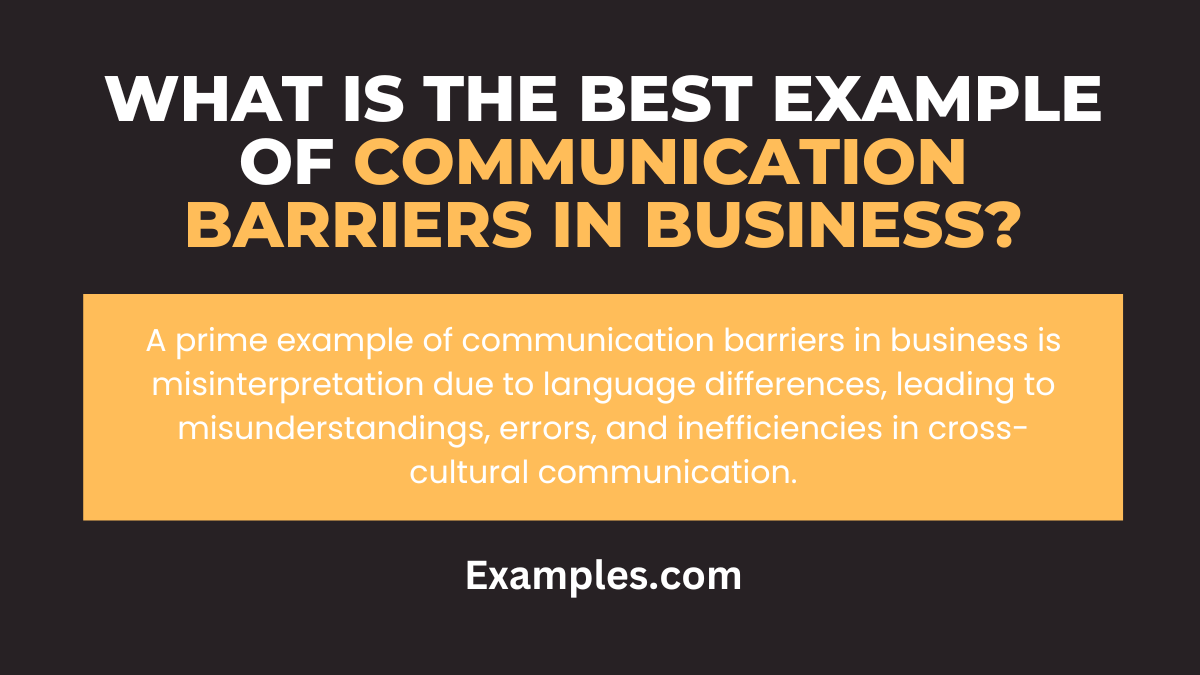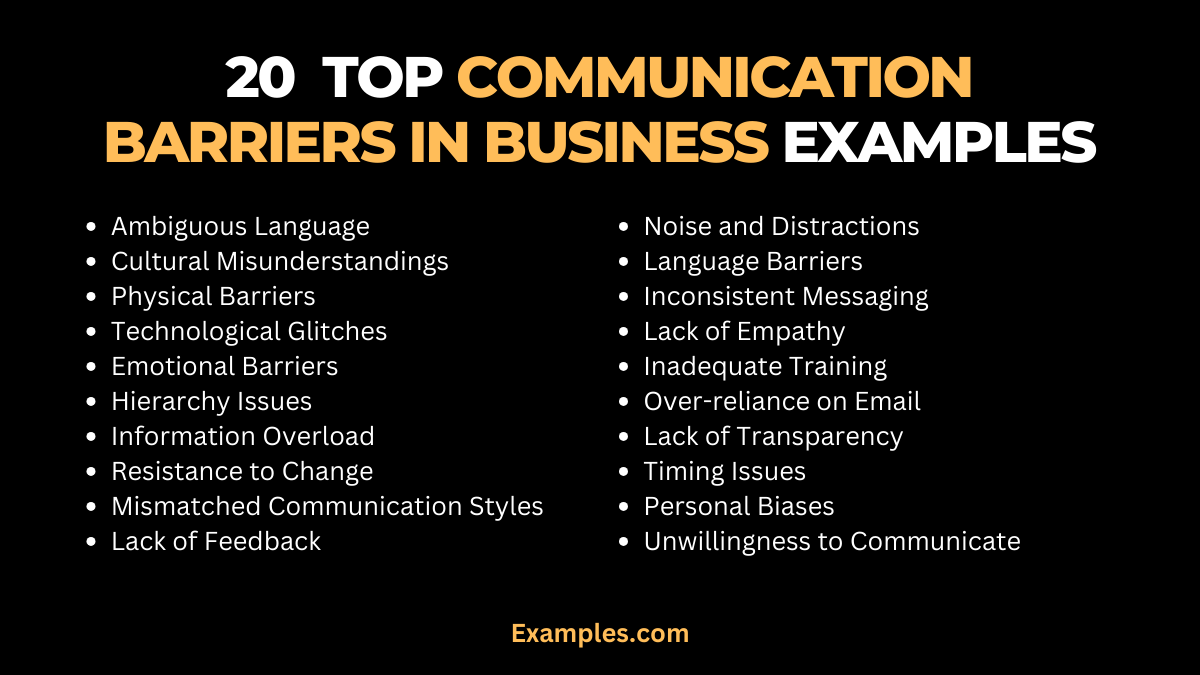19+ Communication Barriers in Business Examples
Dive into the intricacies of Communication Barriers in Business with our comprehensive guide. Uncover the nuances hindering effective communication and explore real-world Communication Examples illustrating common challenges. From cultural differences to technological hurdles, we dissect each barrier. This insightful guide not only highlights the issues but also equips you with actionable solutions, ensuring you navigate the complex terrain of business communication with finesse. Enhance your understanding and overcome obstacles for seamless and impactful interactions in the professional realm.
What are Communication Barriers in Business?

A lack of communication in a relationship refers to the absence or insufficiency of open, honest, and meaningful exchanges between partners. It signifies a breakdown in conveying thoughts, feelings, and needs, leading to misunderstandings and emotional distance. When communication falters, trust can erode, and unresolved issues may escalate. Recognizing and addressing this deficiency is crucial for maintaining a healthy and thriving relationship, fostering intimacy, and building a strong foundation for mutual understanding and support.
What is the Best Example of Communication Barriers in Business?

Integrated Marketing Communication seamlessly blends various promotional methods to convey a consistent brand message. A stellar example is Coca-Cola’s “Share a Coke” campaign. This initiative combined personalized packaging with a strong social media presence, TV ads, and experiential marketing. By incorporating print, digital, and in-person elements, the campaign engaged consumers across multiple touchpoints, fostering a cohesive brand experience. The synergy of these channels demonstrated the power of IMC in creating a unified and impactful brand narrative, resulting in widespread consumer participation and brand affinity.
20 Top Communication Barriers in Business Examples

Discover the intricacies of business communication through 20 vivid examples of communication barriers. From ambiguous messages to cultural differences, this comprehensive guide sheds light on common hurdles hindering effective dialogue. Uncover the impact of these barriers and explore practical solutions for seamless communication in the professional realm. Elevate your understanding and equip yourself with actionable insights to overcome these challenges, fostering a more collaborative and productive business environment.
- Ambiguous Language:
- Cause: Vague wording leads to confusion.
- Fix: Use clear, precise language to convey messages.
- Cultural Misunderstandings:
- Cause: Diverse backgrounds create misinterpretations.
- Fix: Foster cultural awareness and provide cross-cultural training.
- Physical Barriers:
- Cause: Geographical distances impact communication.
- Fix: Leverage technology for virtual collaboration and use multiple communication channels.
- Technological Glitches:
- Cause: Issues with tools hinder effective communication.
- Fix: Invest in reliable communication technology and provide training.
- Emotional Barriers:
- Cause: Negative emotions impede communication.
- Fix: Encourage emotional intelligence and open dialogue.
- Hierarchy Issues:
- Cause: Power imbalances restrict open communication.
- Fix: Foster a culture of open communication, regardless of hierarchy.
- Information Overload:
- Cause: Too much information leads to confusion.
- Fix: Prioritize and streamline information sharing.
- Resistance to Change:
- Cause: Fear of change hinders communication.
- Fix: Communicate the benefits of change and address concerns proactively.
- Mismatched Communication Styles:
- Cause: Differences in styles lead to misunderstandings.
- Fix: Foster awareness of diverse communication styles and adapt as needed.
- Lack of Feedback:
- Cause: Absence of feedback limits improvement.
- Fix: Encourage regular feedback loops to enhance communication effectiveness.
- Noise and Distractions:
- Cause: External disruptions affect communication.
- Fix: Minimize noise, create dedicated spaces for focused communication.
- Language Barriers:
- Cause: Differences in language lead to misunderstandings.
- Fix: Provide language training or use translation tools as needed.
- Inconsistent Messaging:
- Cause: Mixed signals create confusion.
- Fix: Ensure a unified message across all communication channels.
- Lack of Empathy:
- Cause: Absence of understanding hampers communication.
- Fix: Promote empathy and active listening in the workplace.
- Inadequate Training:
- Cause: Lack of communication skills training.
- Fix: Provide comprehensive communication training for employees.
- Over-reliance on Email:
- Cause: Misinterpretations due to text-only communication.
- Fix: Encourage face-to-face or video communication for important messages.
- Lack of Transparency:
- Cause: Withholding information breeds mistrust.
- Fix: Foster a culture of openness and transparency.
- Timing Issues:
- Cause: Messages delivered at inappropriate times.
- Fix: Consider the timing and urgency of communications.
- Personal Biases:
- Cause: Prejudices influencing interpretations.
- Fix: Promote diversity training and awareness.
- Unwillingness to Communicate:
- Cause: Some team members avoid communication.
- Fix: Encourage a culture of open dialogue and collaboration.
By understanding these examples, their causes, and implementing effective solutions, businesses can navigate and overcome communication barriers, fostering a more efficient and harmonious working environment.
How to Overcome Communication Barriers in Business?
- Clear Protocols: Establish transparent communication guidelines.
- Diverse Channels: Utilize varied communication methods.
- Cultural Sensitivity: Address and respect cultural differences.
- Training: Provide communication skills training.
- Feedback: Encourage regular feedback loops.
- Technology: Embrace tools for efficient communication.
- Open Culture: Foster an environment of openness and trust.
- Collaboration: Enhance overall communication for improved collaboration.
How are Communication Barriers Affecting Businesses?
Communication barriers lead to misunderstandings, reduced productivity, strained relationships, errors, conflicts, and limited growth. Addressing cultural disparities, promoting openness, and utilizing effective channels are crucial solutions.
- Misunderstandings: Result in confusion and errors.
- Reduced Productivity: Hampers workflow and task execution.
- Strained Relationships: Impacts collaboration and team morale.
- Errors: Contributes to mistakes in processes and decision-making.
- Conflicts: Escalates tensions among team members.
- Limited Growth: Restricts adaptability and innovation.
- Addressing Cultural Disparities: Promoting cultural awareness and sensitivity.
- Promoting Openness: Fostering an environment of transparent communication.
- Utilizing Effective Channels: Embracing diverse communication methods.
- Overcoming Barriers: Promoting open communication and addressing cultural disparities.
Different types of Barriers of Business Communication?
Explore diverse barriers like physical, semantic, psychological, organizational, cultural, technological, interpersonal, channel-related, perceptual, and environmental hindrances impacting effective communication in business settings.
- Physical Barriers: Geographical distances and remote work impact communication.
- Semantic Barriers: Challenges in language, jargon, and semantics.
- Psychological Barriers: Emotions, perceptions, and attitudes affecting communication.
- Organizational Barriers: Hierarchy, policies, and procedures hindering communication.
- Cultural Barriers: Diverse cultures impacting communication styles.
- Technological Barriers: Outdated technology and digital divides affecting communication.
- Interpersonal Barriers: Personality differences and conflicts influencing communication.
- Channel Barriers: Inappropriate use of communication channels.
- Perceptual Barriers: Individual biases affecting message interpretation.
- Environmental Barriers: Physical surroundings impacting communication effectiveness.
What are the Communication Barriers in Business with Communication?
- Lack of Clarity: Ambiguous messages create confusion.
- Noise and Distractions: Disruptions impede communication.
- Cultural Differences: Diverse backgrounds lead to misunderstandings.
- Physical Barriers: Distance or remote work hinders communication.
- Technological Issues: Glitches affect digital communication.
- Lack of Feedback: Absence of timely input limits improvement.
- Emotional Barriers: Negative emotions impact communication.
- Hierarchy Challenges: Power imbalances hinder open dialogue.
- Information Overload: Too much data leads to confusion.
- Mismatched Communication Styles: Differences in styles result in misunderstandings.



